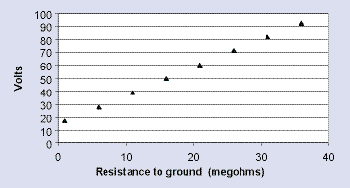2005 Articles
Setting Up the ESD Area
The first step: know your materials’ ESD sensitivity.
Setting up an ESD workstation or area to reduce the risk of ESD is a matter of understanding your processes and installing the necessary and proper ESD avoidance materials. However, simply installing ESD avoidance materials and items without understanding how they will impact your processes may cause misunderstanding and misuse among employees. It is always best if ESD avoidance materials and items work seamlessly with your processes. This enables control of electrostatic charge generation, charge accumulation and any subsequent discharges that are above your predetermined tolerance level without doing anything unusual.
First, understand the ESD sensitivity of the materials or components involved in your processes. Once you have settled on that level you can efficiently design the controls. If personnel are handling unprotected product (outside of protective containers or packages), a means of personnel grounding must be established. Also needed is a protective worksurface upon which to place the sensitive product while performing the necessary operations.
The design of the grounding system depends on your needs. A main consideration is whether personnel have to be mobile. If they require mobility, a floor and footwear system that provides a path to ground through the personnel is generally recommended. Today, a resistance-to-ground specification of <3.5 x 107 � (35 M�) is considered optimum for most applications where �100V human body model (HBM) parts are handled. It is also important to understand charge generation characteristics of the floor and footwear system. Make certain that the peak voltage generated by contact and separation of footwear from the floor does not exceed predetermined limits (generally �100V measured on the person for most applications – see ANSI/ESD STM 97.2). If extremely sensitive products are processed, the resistance-to-ground level and the voltage generation level must be set lower. A common rule of thumb is to reduce the resistance-to-ground level to <1 x 107 � (10 M�) and the voltage level to <50V for extremely sensitive parts. Figure 1 shows the relationship of resistance-to-ground and voltage generation on personnel. Increased resistance-to-ground allows higher charge generation and accumulation.
 FIGURE 1: Voltage on personnel. |
If personnel are seated to do their work, a wrist strap grounding system must be employed since seated personnel rarely have their feet in solid contact with the floor. Even with an ESD control floor and footwear system in place, seated personnel have to use a wrist strap or equivalent type of grounding system to ensure consistent, continuous grounding. The resistance-to-ground specification for a wrist-strap grounding system is the same as for a floor-footwear system: �35 M� for a 100V HBM program and �10 M� for more sensitive applications.
Verification that the grounding system is functioning correctly is of major importance. In general, the higher the risk or cost of failure, the more often you need to check the grounding system. Most companies establish a minimum of one test per shift for personnel grounding. Many companies require a retest each time a person returns to their workstation. In high-reliability or high-risk situations, continuous monitoring may be required. Once only required for military electronics, many companies now find it cheaper to use continuous monitoring as it reduces test time and recordkeeping. Personnel are taught to stop work when the wrist-strap monitor sounds an alert so that the problem can be fixed immediately.
Floor and footwear system specification verification is usually done with less frequency than wrist strap checks. ESD control shoes are not prone to change as much as wrist straps, but do not get complacent. Shoe grounding straps can be installed incorrectly and should be checked each time they are put on.
Properly installed floors do not change much over time but can get ruined with improper maintenance. Putting the wrong wax on a conductive floor will alter the performance. Most companies require a retest of a floor after cleaning or maintenance to make sure the electrical properties are unchanged.
Worksurfaces can be a tabletop, workbench, conveyor, machine surface or any other place that will hold products during a process; thus the mechanical and physical equirements for a worksurface will vary with each application. In general, the main electrical requirement of an ESD protective worksurface is to permit a charge to drain from conductive or dissipative items that are placed on that surface. How rapidly the charge drains depends on the resistance of the worksurface and the contact resistance between the surface and the item. If the item is a charged ESD susceptible part, avoid Charge Device Model (CDM) issues. However, proper handling of parts will reduce charge generation and charge accumulation on the part, thus reducing CDM issues at the same time. Many companies operate facilities with very conductive worksurfaces (e.g., stainless steel benches) with no ESD issues.
David E. Swenson retired from 3M after 35 years in ESD control material development and application. He is cofounder and president of Affinity Static Control Consulting (affinity-esd.com), and VP of sales and marketing at Electronic Polymers Inc. (electronicpolymers.com).
This column is a regular contribution of the ESD Association (esda.org).




